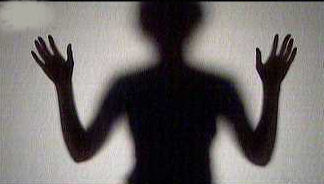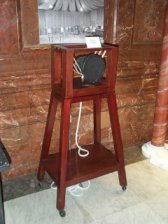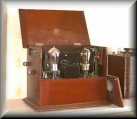Description - added words in the dialogue to fill in what is 'blind' for the listener
"There You Are On The Sofa With Your Box Of Chocolates, Irene" Rule
Example from BBC soap, 'The Archers':
FX : (TONY DIGGING, GRUNTING. OUTSIDE ACOUSTIC. SPADE ON EARTH)
PAT: (approaching) Still digging the carrots, Tony?
|
DESCRIPTION - mostly of physical details, facial expressions, gestures and bodily action. See BELOW for examples. |
|
SCRIPTING - demands skill - must not be obstrusive or clunky - a test of the playwright |
| Often needed at the start of a scene - part of SIGNPOSTING. Some scenes and action demand more DESCRIPTION. |
|
SCRIPT also as the NARRATOR 'voice in the mind' - Interiorizing - the voice in the mind - (technique) POSITION ONE - fully private and subjective - telling secrets |
|
The 'added extra' in radio drama - what this medium demands as an aural-only, 'blind' medium. |
|
DESCRIPTION + CONTRADICTION of what the character says. Kind words, for example, hiding suspicion, or politeness masking fear. Often in TV thrillers and police interrogation scenes, where hidden motives lurk. DESCRIPTION cuts through to the listener and opens out the psychological contradiction. |
| DESCRIPTION does the work of the TV / film camera searching out revealing changes in the character's face. |
|
Examples of DESCRIPTION 'The Kingston File' - an exciting police thriller scene, the
girl in the police car describes the house siege down the hand-held
police car microphone to headquarters officers. How to use DESCRIPTION with Reverberation (echo) Description is a term invented by Alan Beck - and is not established as a term in professional radio drama production. See 'mise-en-scène' - representation of the play scene, locations, spaces and perspectives Description and the 'silent character'
For most of the play, there is a vivid interactive 'dialogue' with her. It is created by continuous description, coming from her lover and from her friends. The irony is, of course, that they misread her physical signals. Then the radio listeners, who do not have direct access to these, are let into the truth about her - her own direct monologue to them.
END OF SECOND LAST SCENE LORNA: ............ well, I wanted to say sorry FINAL SCENE Gemma's flat. The Garden. Morning. No music.
Comments on description Rodger, RADIO DRAMA (1982) 10: Gielgud, THE RIGHT WAY TO RADIO PLAYWRITING (1948) 51: Felton, THE RADIO-PLAY. ITS TECHNIQUES AND POSSIBILITIES (1949)
45: Felton, Felix, 1949, The Radio-play: its techniques and possibilities, London: Sylvan Press. Gordon Lea, RADIO DRAMA AND HOW TO WRITE IT (1926) (This is the first book on the technique of radio drama).
BIBLIOGRAPHY - Radio Drama - Sound - Film Sound |
Continuing through this site: establish presence and scene boundaries
| establish presence |
|
|
| Perspective |
|
|
|
|
|
|
|
|
|
|
|
|
|
|





